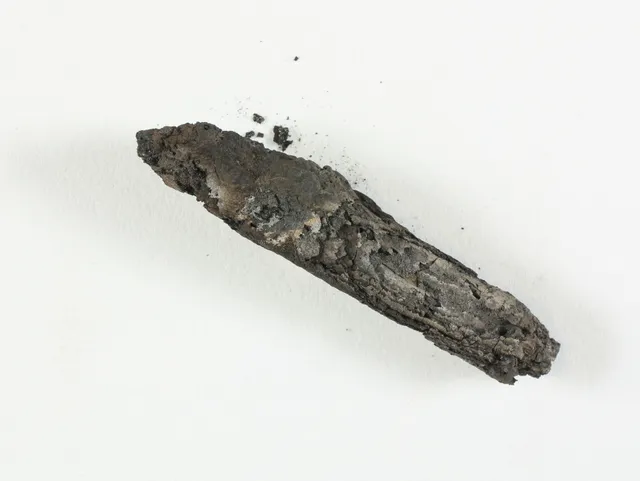1,500-Year-Old Text Has Been Digitally Resurrected From a Hebrew Scroll
Special software helped reveal the words on a burned scroll found inside a holy ark near the Dead Sea
/https://tf-cmsv2-smithsonianmag-media.s3.amazonaws.com/filer/b4/c0/b4c0d394-3a17-4ed4-9bbb-801aeb65fc22/partial_unwrap-20150528140903_copy.jpg)
More than four decades ago, an archaeologist discovered a scroll in the ruins of an ancient settlement built near the Dead Sea. Found inside a holy ark, the fragile document was so badly burned that the scientist decided not to risk unrolling it, lest it crumble to pieces. Kept safe in storage ever since, the Ein Gedi scroll has held on to its secrets—until now.
This week a computer scientist announced that his team found a way to unroll the scroll virtually. Working off x-ray scans of the artifact, specialized software detected the layers of parchment and digitally unwound them, revealing for the first time Hebrew characters written on the scroll about 1,500 years ago.
“I’ve actually never seen the actual scroll,” says Brent Seales, a professor at the University of Kentucky. “For me, that’s a testament to the power of the digital age.”
His interest in damaged texts began years ago with a cache of old Roman scrolls unearthed at what had once been the resort town of Herculaneum. Buried during the infamous A.D. 79 Vesuvius eruption, the Herculaneum scrolls seemed like little more than cylinders of charcoal. To try and take a deeper look, Seales and his colleagues bombarded the relics with x-rays from a micro-CT scanner—a device similar to the computerized tomography scanners hospitals use to see inside human bodies, but much more powerful.
“It’s a bit expensive and time-consuming to do, but you’re able to see inside an object without destroying it,” says James Miles, a graduate student at the University of Southampton and director of Archaeovision, a company that scans ancient objects. “You can’t do this any other way.”
To suss out the contours of rolled papyri, Seales wrote a computer program. He likens the process to cartography: the density data from a micro-CT scan is a whole world of chaotic shapes and forms, and the turns of the papyri are like edges of continents that his algorithms can sketch. Sadly, his x-rays and algorithms proved blind to the carbon-based ink on the Roman scrolls, which was too similar to the carbonized papyri to be distinguished.

Still, word about Seales' software reached the Israel Antiquities Authority (IAA). They already had the Ein Gedi scroll scanned with a micro-CT machine but couldn’t make sense of the information. Could Seales help? A meeting was arranged in the U.S., and over lunch, he was handed a hard drive containing terabytes of raw data. Though in much better condition than the Roman scrolls, the Hebrew parchment offered its own challenges. Made of animal skin instead of plant-based papyrus, it had bubbled and blistered over the years. New programming tricks that corrected for those imperfections in the data would be needed.
“This is probably a simpler problem than the Herculaneum scrolls, which are really the worst-case scenario in the field,” says Vito Mocella of the Italian National Research Council, who heads the Italian team that ultimately found a way to read letters on the Roman scrolls using an enhanced scanning technique and a powerful particle accelerator. “But even if it’s simpler, it’s still not so easy.”
Luckily for Seales, the Hebrews added metal to their inks, which showed up clearly as bright white spots in the CT data. As his software virtually unwound a single layer from the middle of the scroll, text revealed itself: “The LORD summoned Moses and spoke to him,” it began. Israeli translators identified the words as the first verse of Leviticus, the book of laws.
“This discovery absolutely astonished us: We were certain it was just a shot in the dark but decided to try and scan the burnt scroll anyway,” Pnina Shor, curator and director of IAA's Dead Sea Scrolls Projects, says in a statement. The IAA unveiled the achievement at a press briefing in Israel on July 20.
For Biblical scholars, discovering another copy of the Book of Leviticus isn’t exactly Earth-shattering. “There's little of surprise in finding a Leviticus scroll,” says James Aitken, a lecturer in Hebrew at the University of Cambridge. “We probably have many more copies of it than any other book, as its Hebrew style is so simple and repetitive that it was used for children's writing exercises.”
What makes the sixth-century text remarkable, says Aitken, is its age. Until 1947, the oldest known Biblical texts dated to the tenth century. Then Bedouin goat herders exploring the Qumran caves discovered the iconic Dead Sea scrolls, which date from between the third century B.C. and the first century A.D. The Ein Gedi scroll is one of only three deciphered documents dated to the long gap between, says Aitken—the other two being a fragment of Genesis thought to be from the sixth century and an Exodus scroll from the seventh or eighth century.
As Seales works to finish decoding the rest of the Ein Gedi scroll, he’s making plans to start on other scrolls found at the same site. And with his growing reputation for resurrecting texts from the dead, other projects have come calling—including a novel from the early 20th century that was torched in a house fire.
“When you have a new technology like this, it moves the line of what is possible,” he says. “People start to think about studying materials they had no way to study before.”

